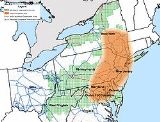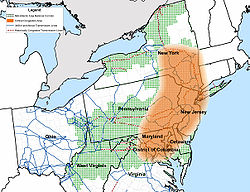
National Interest Electric Transmission Corridor
Encyclopedia

United States Department of Energy
The United States Department of Energy is a Cabinet-level department of the United States government concerned with the United States' policies regarding energy and safety in handling nuclear material...
where electricity transmission limitations are adversely affecting American citizens. In 2005 the United States Congress
United States Congress
The United States Congress is the bicameral legislature of the federal government of the United States, consisting of the Senate and the House of Representatives. The Congress meets in the United States Capitol in Washington, D.C....
granted the Department of Energy the authority to create these regions in an effort to speed the creation of more transmission capacity. Should state and local governments fail to issue permits allowing construction of new transmission, the Energy Policy Act of 2005
Energy Policy Act of 2005
The Energy Policy Act of 2005 is a bill passed by the United States Congress on July 29, 2005, and signed into law by President George W. Bush on August 8, 2005, at Sandia National Laboratories in Albuquerque, New Mexico...
gives the Federal Energy Regulatory Commission
Federal Energy Regulatory Commission
The Federal Energy Regulatory Commission is the United States federal agency with jurisdiction over interstate electricity sales, wholesale electric rates, hydroelectric licensing, natural gas pricing, and oil pipeline rates...
(FERC) the authority to issue a federal permit empowering a project director to exercise the right of eminent domain
Eminent domain
Eminent domain , compulsory purchase , resumption/compulsory acquisition , or expropriation is an action of the state to seize a citizen's private property, expropriate property, or seize a citizen's rights in property with due monetary compensation, but without the owner's consent...
to purchase property needed to complete the project.
Background
In the United States, electricity generation is growing 4 times faster than transmission, and energy sources that would make the U.S. more energy independent cannot be built because there is no transmission capacity to carry the power to consumers. Because United States energy independence is a national priority, this problem has attracted considerable federal attention.Historically, local governments have exercised authority over the electricity grid
Grid (electricity)
An electrical grid is a vast, interconnected network for delivering electricity from suppliers to consumers. It consists of three main components: 1) generating plants that produce electricity from combustible fuels or non-combustible fuels ; 2) transmission lines that carry electricity from power...
and have little incentive to take action that would benefit other states, but not their own. States with cheap electricity have a disincentive to make interstate commerce in electricity easier, since other states will be able to compete for local energy and drive up rates. Further, vocal local constituencies can block or slow permitting by pointing to visual impact, environmental, and perceived health concerns.
Large transmission upgrades require coordination of multiple states, a multitude of interlocking permits, and a significant portion of the 500 companies that own the grid. From a policy perspective, the control of the grid is balkanized, and the former Energy secretary
United States Secretary of Energy
The United States Secretary of Energy is the head of the United States Department of Energy, a member of the President's Cabinet, and fifteenth in the presidential line of succession. The position was formed on October 1, 1977 with the creation of the Department of Energy when President Jimmy...
Bill Richardson refers to it as a "third world grid". To address to the U.S. national security interest in significantly growing transmission capacity, the 2005 energy act
Energy Policy Act of 2005
The Energy Policy Act of 2005 is a bill passed by the United States Congress on July 29, 2005, and signed into law by President George W. Bush on August 8, 2005, at Sandia National Laboratories in Albuquerque, New Mexico...
gave the Department of Energy the authority to approve transmission if states refuse to act. However, soon after using its power to designate two national corridors, 14 senators signed a letter stating the DOE was being too aggressive
Corridor designations of 2007

FERC permit for a project
Specific routes for specific projects will rely on state siting authorities or possibly FERC should a federal permit be issued. FERC may issue a permit only if the project organizer can show that their proposal will significantly reduce a transmission constraint in the national corridor. According to the DOE, NIETC permit process should not disrupt siting activities of state authorities, and will investigate allegations that an applicant has acted in bad faith in state proceedings.When a specific route is chosen for a project, FERC will conduct an environmental impact statement
Environmental impact statement
An environmental impact statement , under United States environmental law, is a document required by the National Environmental Policy Act for certain actions "significantly affecting the quality of the human environment". An EIS is a tool for decision making...
(EIS) prior to groundbreaking. DOE did not conduct an EIS for either NIETC region arguing that the designation does not authorize any specific projects or routes.
See also
- Electricity transmission corridor
- Electric power transmissionElectric power transmissionElectric-power transmission is the bulk transfer of electrical energy, from generating power plants to Electrical substations located near demand centers...
- Super gridSuper gridA super grid is a wide area transmission network that makes it possible to trade high volumes of electricity across great distances. It is sometimes also referred to as a "mega grid".-History:...
- Unified Smart GridUnified Smart GridUnified National Smart Grid is a proposal for a United States wide area grid that is a national interconnected network relying on a high capacity backbone of electric power transmission lines linking all the nation's local electrical networks that have been upgraded to smart grids...

